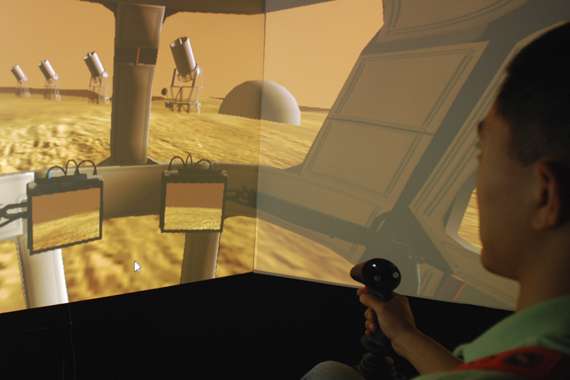Astronaut Fatigue on NASA's Radar
Description
CQUniversity's Deputy Dean of Research in the School of Engineering and Technology, Professor Steve Moore's research into how astronauts recover from prolonged space missions, will be beneficial to future trips to the Moon and Mars. Prof Moore's research project, funded by NASA, put recently returned astronauts to the test in a series of driving, flight and mars rover simulators. The results showed that the astronauts had difficulty performing driving and piloting tasks on the day of return from space due to prolonged exposure to microgravity.
Impact
The project will influence decisions around future space missions. Students at CQUniversity's Aviation Centre in Cairns, Queensland, will also benefit with the University acquiring one of NASA's flight simulators.
Professor Steven Moore
With NASA looking to return to the moon in the next five years, the space agency will need to focus on how it will protect its astronauts from the rigours of space travel.
That's according to Professor Steven Moore, whose research into astronaut performance and the effects of microgravity on the human body is one of the key pieces of consideration in NASA's space program, whether it be a short trip to the International Space Station or one to Mars.
As CQUniversity's Deputy Dean of Research in the School of Engineering and Technology since 2016, Prof Moore has brought with him a wealth of knowledge and experience in biomedical engineering – including a 20-year stint with the Icahn School of Medicine at Mount Sinai in New York, where he was first approached by NASA to research the health impacts of long duration space travel on its astronauts.
Prof Moore has previously conducted a number of research projects on human vestibular reflexes, before coming to NASA's attention while undertaking his PhD into 3D eye tracking systems at the University of Sydney. NASA had found that some of its astronaut pilots were experiencing difficulties landing the space shuttle when returning to Earth and invited Professor Moore to delve deeper into the performance issues the astronauts were enduring.
His research, which received $2.7 million in NASA funding over seven years, was conducted at NASA's Johnson Space Center in Houston and involved two test groups – a group of recently-returned astronauts from six months aboard the International Space Station and a second group of people who were essentially sleep-deprived for 36 hours. The groups were given tasks including operating landing and driving simulators to test their performance.
After returning to Australia and CQUniversity, Prof Moore scrutinised his team's findings. The research showed that the astronauts had a marked deficit in their hand-eye coordination and their ability to handle multiple mental tasks, compared to the sleep-deprived group. The astronaut group alone also exhibited poor performance on the driving and piloting simulations.
"(The deficit) was very pronounced in the astronauts – the main problem was that they couldn't handle dual tasks and these were ex-military pilots so the results were quite surprising to us," Prof Moore explains.
"They not only have microgravity to contend with up there, but also radiation and levels of carbon dioxide from being in the confined space of the space station for so long.
"However, the astronauts' coordination deficit was short-lived as they returned to baseline within four days of returning to Earth after six months in space."
Prof Moore says the findings were of great interest to NASA as it showed that the issue could be managed; and that one solution would be to have astronauts sharing tasks during critical operational tasks such as landing a spacecraft.
With NASA looking to send astronauts to Mars in the near future, and the Biden administration looking to return to the moon by 2024, Prof Moore says his performance research was just one of many factors that would contribute to the space agency's plan.
"They have a group of mission architects who are strategising what a Mars mission would look like. My research has factored into that mission planning. They'd have to be looking at the design of spacecraft and the effects of zero gravity on the body," he says.
Prof Moore highlights that some astronauts had suffered and still do suffer the effects of intra-cranial pressure where the lack of gravity forces bodily fluids into the head. He says radiation would also be a major factor with cataracts a common problem for astronauts.
Prof Moore is continuing his research with the Australian Space Agency and NASA. Dr Moore was recently awarded an OSPRO grant by CQU to support a 3-month sabbatical at NASA Johnson and Kennedy Space Centers in 2023 as a co-investigator on the next round of studies. These aim to have returning astronauts perform actual piloting tasks in real (not simulated) aircraft to better determine what procedures need to be in place to safely perform complex operational tasks after prolonged periods of microgravity, which would be up to 18-months for a journey to Mars. He says this has the potential to benefit other CQUniversity researchers and students, particularly at the recently opened Cairns Aviation Centre, which has a growing number of aviation research projects in human factors.
Ultimately, Prof Moore says the biggest stumbling block for future space exploration would be a political and economic one, but he believes a trip to the moon would make a much-needed practice run for a mission to Mars.
Connect with CQUniversity
At CQUniversity we know the value of our connections locally and around the world. Our partnerships help us create opportunities, deliver solutions and change lives. From time to time, we share our Connections Count update where we share our highlights, including research impact stories like the ones below. Sign up to become one of our valued connections.

